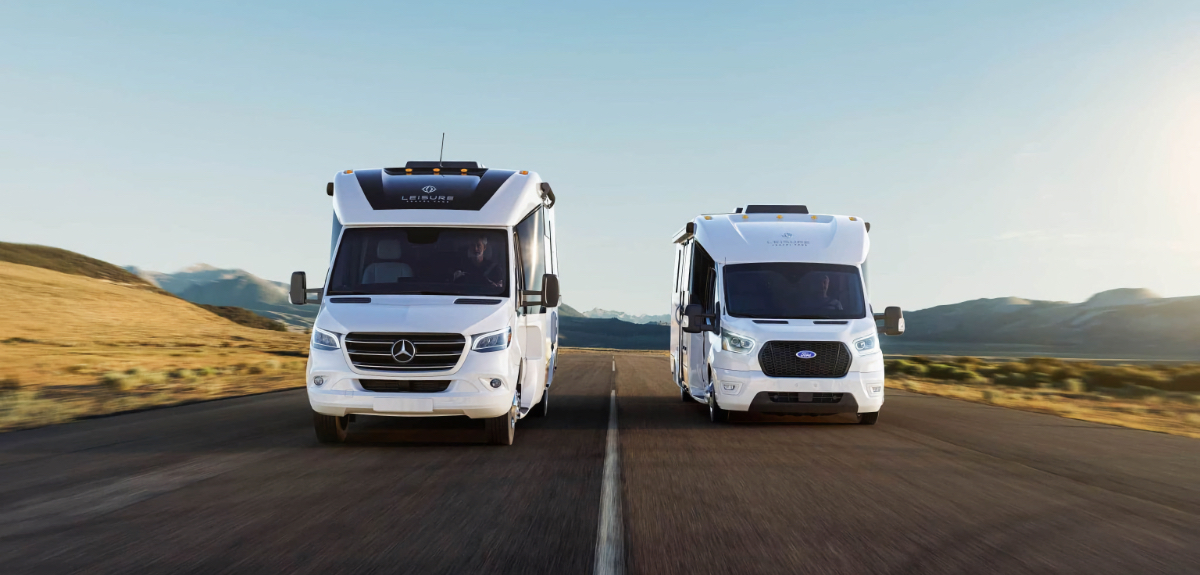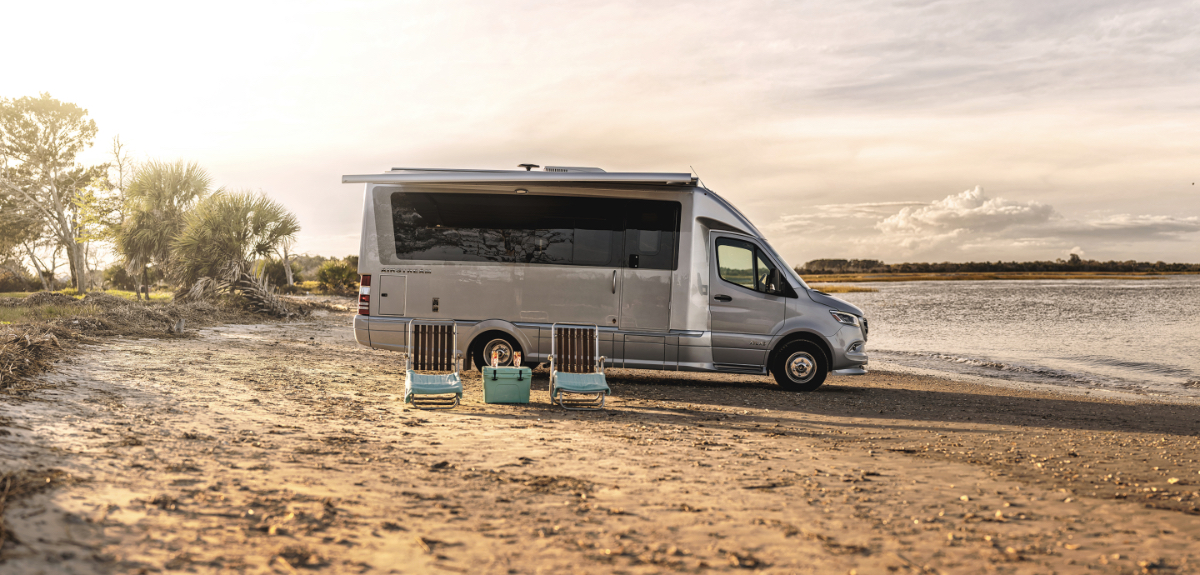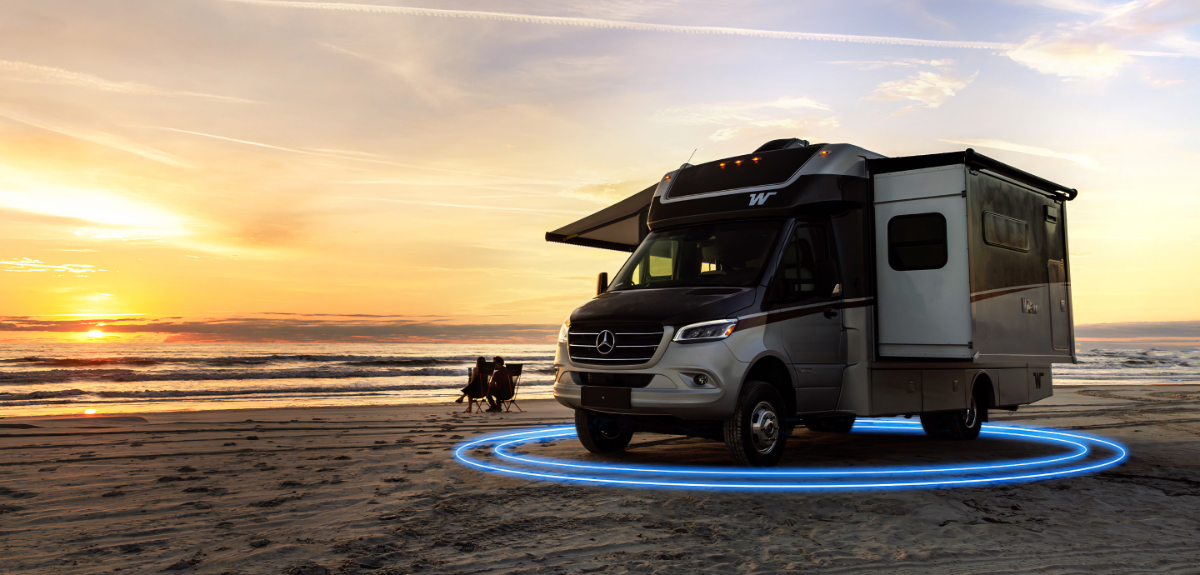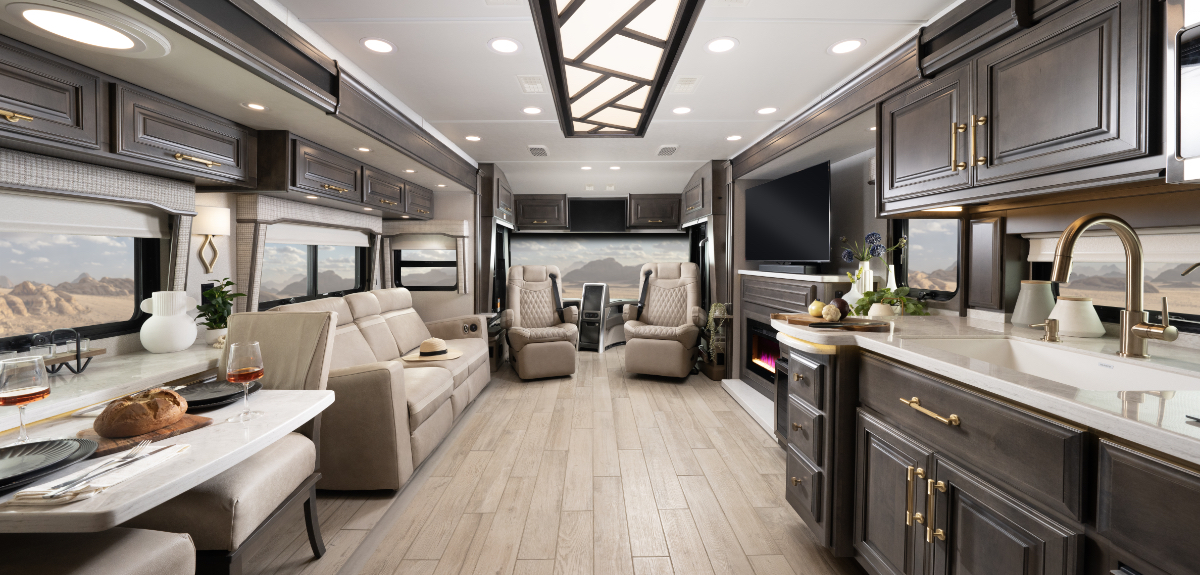Chassis Choices: How to Choose The Best Bones
Image Caption:
When most of us look at a motorhome, our tour starts and ends with the interior. After all, that’s where we’ll be spending the bulk of our time with friends and family, so we want it to be well equipped, comfortable and suitable for the lifestyle we plan to lead. It’s easy to be swept away by leather furniture, solid-surface countertops and stainless-steel appliances, but what about the driving experience? Most consumers only take a short test drive before purchasing, and worse yet, some don’t even take their desired motorhome off the lot before signing on the dotted line. Once you take possession, it would be a shame to realize later on that you could have had something better, wouldn’t it?
There are hundreds of motorhomes to choose from, ranging from compact Class B’s to 45-plus-foot diesel pushers, all based on what seems like a handful of available chassis by comparison. But it’s important to understand that, while they may be built by the same manufacturer, they may not all be the same. For example, one motorhome manufacturer may order 100 chassis from Ford equipped a certain way, while another may order it outfitted another way — so you may have two competitive motorhomes, one with a better-equipped chassis than the other. Some motorhome manufacturers might also add their own touches to a particular chassis to make it ride/handle better, and more insulation to ensure a quieter ride. As you climb higher up the price ladder, the differences can become more pronounced, as chassis manufacturers offer their customers more latitude to add special or even exclusive features. Here, it becomes even more important to conduct your own due diligence and shop around.
To give you some idea of what’s available, we’ve compiled this handy chassis guide with the most pertinent specifications, and a short overview of each, based on our own experiences. Reading this may not be as inspiring as luxury décor or full-body paint schemes, but it could prevent buyer’s remorse and lead to a long, happy relationship with a new motorhome.
Ford E-350/E-450
Engine(s): 6.2-liter V-8, 331 hp/356 lb-ft; 6.8-liter V-10, 305 hp/420 lb-ft
Transmission: Six-speed TorqShift automatic transmission with tow/haul mode and SelectShift
Drive system: Rear wheel drive
Suspension front/rear: Twin I-Beam independent front suspension (IFS) with coil springs and gas shock absorbers/multi-leaf springs with gas shock absorbers
Brakes: Four-wheel disc with ABS
Wheelbases: 138″, 158″, 176″ (E-350); 158″, 176″ (E-450)
Fuel capacity: 40 gal (Std. on E-350); 55 gal (Opt. w/158″ DRW E-350 only); 55 gal (Std. on E-450); 40 gal (Opt. on E-450)
GVWR: 10,050 lbs SRW w/138″ or 158″ WB (E-350); 11,500 lbs DRW w/138″ WB (E-350); 12,500 lbs DRW w/158″ or 176″ WB (E-350); 14,000 lbs 6.2-liter, 14,200 lbs/14,500 lbs 6.8-liter (E-450)
GCWR: 18,500 lbs-22,000 lbs
Tow rating: See dealer/RV manufacturer info
Warranty: 3 years/36,000 miles
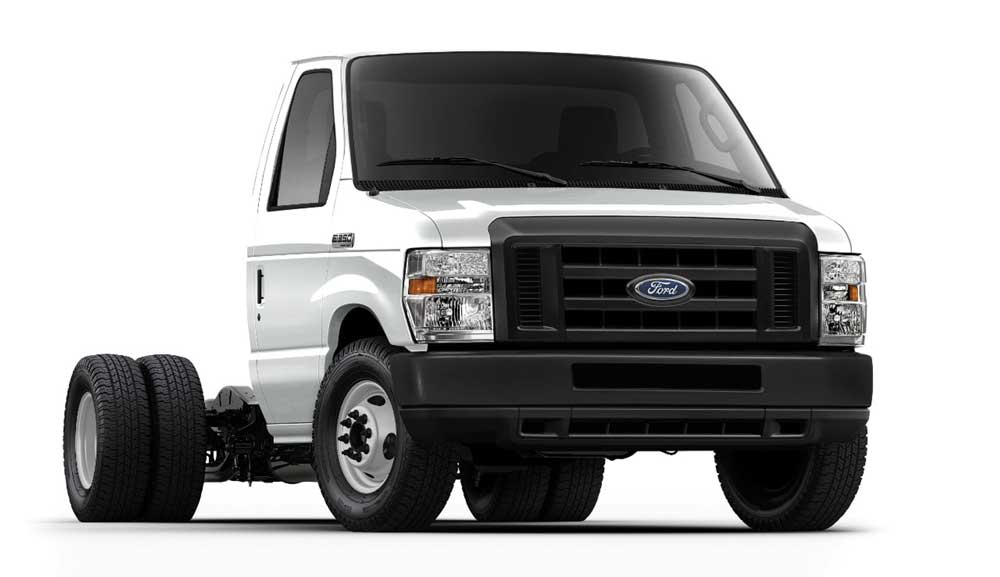
Our take
Despite Ford’s 2014 announcement that it would cease production on the aging E-Series passenger/cargo van to make way for the all-new Transit, the E-350/450 cutaway chassis soldiers on. A popular and cost-effective choice for the RV and commercial vehicle industries, the E-Series remains a decent Class C motorhome chassis, despite its age. With the V-10 engine moved farther forward than in the F-53 Class A chassis, engine sound volume tends to be less pronounced, and the overall chassis dynamics are good, especially in moderately sized motorhomes. Depending, of course, on the motorhome manufacturer, overall length, weight balance and the amount of rear overhang, some E-Series-based motorhomes exhibit more confident handling than others. Make sure you drive a few different models with the same underpinnings before making a choice.
What we’d like to see
Some advanced tech from the Super Duty migrating into the E-Series chassis: a dynamic driver information display, better steering wheel, Sync 3, satellite radio, etc. We know it’s a commercial platform, but motorhome owners should have more luxury options.
Ford F-53
Engine: 6.8-liter V-10, 320 hp/460 lb-ft
Transmission: Six-speed TorqShift automatic transmission with tow/haul mode and SelectShift
Drive system: Rear wheel drive
Suspension front/rear: Solid axle with leaf springs and gas shock absorbers/solid axle with leaf springs and gas shock absorbers
Brakes: Four-wheel disc brakes with ABS
Wheelbases: 158″/178″/190″ (16,000-lb GVWR model); 208″/228″ (20,500-lb GVWR model); 208″/228″/242″ (22,000-lb GVWR model); 228″/242″/252″ (24,000-lb/26,000-lb GVWR models)
Fuel capacity: 80 gal
GVWR: 16,000-26,000 lbs
GCWR: 23,000-30,000 lbs
Tow rating: 4,000-7,000 lbs
Warranty: 3 years/36,000 miles basic
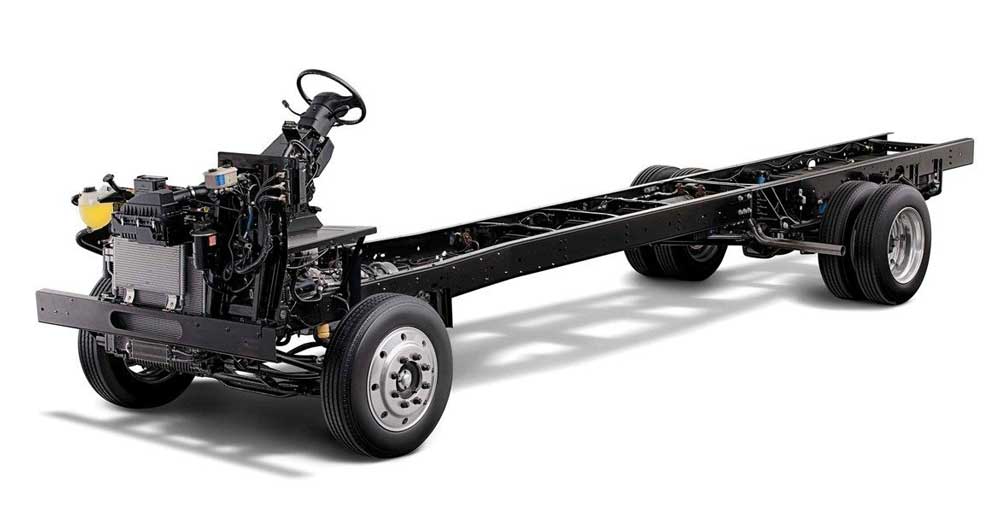
Our take
One of the longest-standing motorhome chassis on the market, and the only gas Class A chassis currently available. In many applications, it can be seen as rough riding for those accustomed to more sophisticated suspension design and the V-10 engine can be underpowered depending on body size, requiring frequent full-throttle, high rpm applications, at which point the engine sound levels can become loud enough to inhibit conversation on long grades. Trying several different motorhomes on the same chassis can pay off, as some manufacturers mitigate some of the negatives with suspension/handling components and extra insulation around the doghouse area. There’s a plethora of aftermarket upgrades for the F-53, however, so if you love a particular motorhome built on the F-53 but the handling or power is less than ideal, you’ll have options for improving both areas.
What we’d like to see
Ford has a very capable 6.7-liter Power Stroke diesel engine that it uses in its Super Duty trucks that is far more powerful, quiet and would likely be more fuel efficient in a motorhome application than the V-10. Combined with an updated, intelligent transmission and useful features like an integrated exhaust brake, this powertrain would keep the F-53 viable for years to come. It would increase the cost (by at least $10,000 if the Power Stroke option in the Super Duty trucks is any indication) but we’d bet that many motorhome owners would be willing to ante up considering the benefits.
Ford Transit
Engine(s): 3.7-liter V-6, 275 hp/260 lb-ft; 3.5-liter EcoBoost V-6, 310 hp/400 lb-ft; 3.2-liter inline five-cylinder Power Stroke turbodiesel, 185 hp/350 lb-ft
Transmission: Six-speed SelectShift automatic
Drive system: Rear wheel drive
Suspension front/rear: Independent MacPherson strut/leaf springs
Brakes: Four-wheel disc with ABS
Wheelbases: 148″ (van) 138″/156″/178″ (cutaway chassis)
Fuel capacity: 25 gal
GVWR: 9,400 lbs (SRW)/10,360 lbs (DRW) (van); 9,500 lbs (SRW) 10,360 lbs (DRW) (cutaway chassis)
GCWR: Max 11,200 lbs (van); Max 13,500 lbs (cutaway chassis)
Tow rating: 4,700 lbs (van) 7,500 lbs (cutaway chassis)
Warranty: 3 years/36,000 miles basic
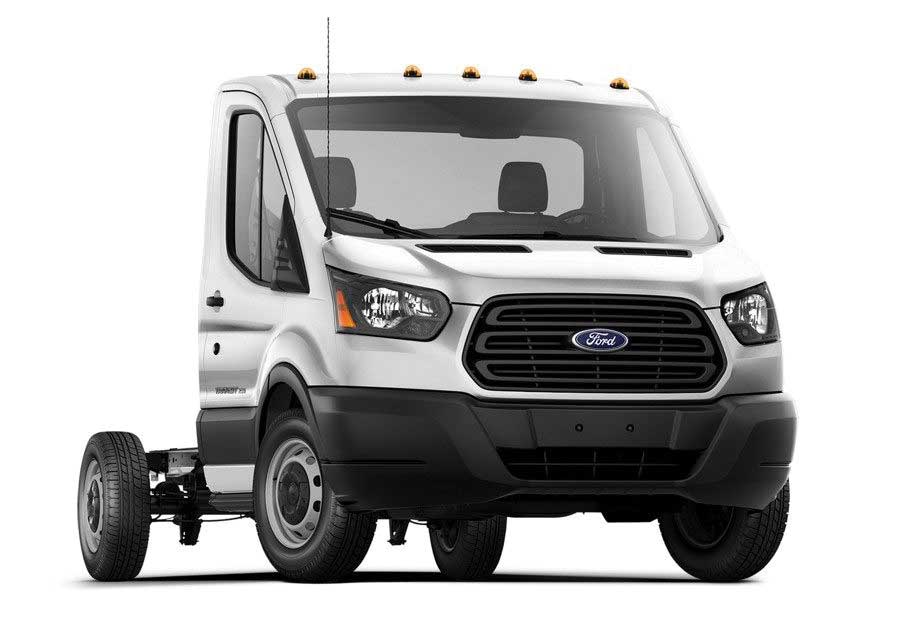
Our take
We can’t say enough good things about the Transit chassis, van or cutaway. It’s available in a multitude of configurations, can be had with excellent gas/diesel engine options, and chassis dynamics are superlative. If you’re on the fence whether to choose a comparable Transit or Sprinter-based motorhome, drive both and we think the choice will be easy.
What we’d like to see
Nothing, really. Ford did its homework on this one.
Freightliner Custom Chassis-XC/SL Series
Engine(s) (XC): Cummins ISB 6.7-liter turbodiesel 300 hp/660 lb-ft; 340 hp/700 lb-ft; 360 hp/800 lb-ft; Cummins ISL 8.3-liter turbodiesel, 380 hp/1,050 lb-ft; Cummins ISL 8.9-liter turbodiesel, 380 hp/1,150 lb-ft; 400 hp/1,250 lb-ft
Engine(s) (SL): Cummins ISX12 turbodiesel, 500 hp/1,645 lb-ft; Cummins ISX15 turbodiesel, 600 hp/1,950 lb-ft; Detroit DD13 turbodiesel, 500 hp/1,650 lb-ft
Transmissions (XC): Allison 2500MH, 3000MH six-speed
Transmission (SL): Allison 4000MH
Drive system: Rear wheel drive
Suspension options front/rear (XC): Detroit Wide-Track I-Beam front axle; Neway AS120 two-spring; ZF independent front suspension/Single-axle Neway ADL transverse beam with air bags; V-Ride Rear Suspension System
Brakes: Air
Wheelbases: 208″-294″ (XC)
Fuel capacity: Custom
GVWR: Up to 47,000 lbs
GCWR: Based on finished vehicle
Tow rating: Based on finished vehicle
Warranty: 3 years/50,000 miles
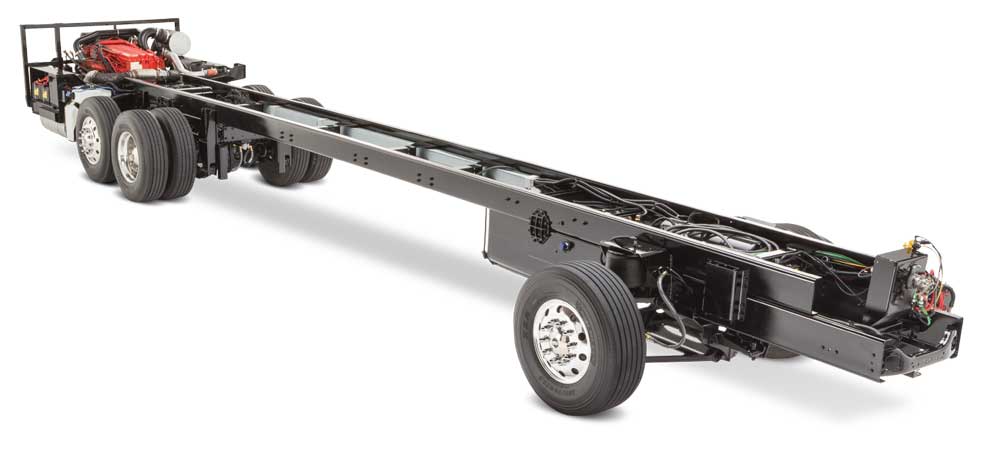
Freightliner motorhome chassis have an available steerable tag axle, which aids in turning and prevents tag tire scrubbing.
Our take
You can’t argue with success. Freightliner, part of the Daimler family, uses its commercial roots and engineering expertise to continually improve its Class A diesel chassis offerings. Combined with a variety of Cummins diesel engine power levels, frame configurations and weight ratings, not to mention a nationwide dealer/support network, and it’s no small wonder that more than 80 percent of all Class A diesel motorhomes ride on the XC chassis, according to Freightliner. The fact that Freightliner builds the XC in four different frame rail configurations (XCS, XCL, XCR and XCM) to provide motorhome manufacturers with a multitude of design options can’t hurt, either. While there are no obvious shortcomings, keep in mind that larger coaches on this platform may feel underpowered, as the maximum horsepower rating is 400.
The SL chassis is designed for coaches at the higher end of the luxury spectrum, and therefore, its custom frame allows manufacturers to choose from nearly any floorplan or length, while a choice of raised or modular frame rails provides additional design options like a flat floor throughout, pass-through basement storage and other benefits. Not surprisingly, the SL also brings with it higher horsepower ratings — a 500-hp Detroit Diesel, or a Cummins in 500-hp or 600-hp designations.
What we’d like to see
From our experience, these chassis are well-sorted and trouble-free.
Freightliner Custom Chassis S2RV
Engine(s): Cummins B6.7-liter turbodiesel, 300 hp/660 lb-ft; 340 hp/700 lb-ft; 360 hp/800 lb-ft
Transmission(s): Allison 2500MH or 3000MH six-speed automatic
Drive system: Rear wheel drive
Suspension front/rear: Detroit axles with custom-taper leaf spring suspension/Detroit rear axle with Airliner air ride suspension
Brakes: Air
Wheelbase(s): 179″-279″
Fuel capacity: 60 gal or 100 gal
GVWR: 26,000-33,000 lbs
GCWR: Based on finished vehicle (30,000-lbs-plus)
Tow Rating: Based on finished vehicle
Warranty: 3 years/50,000 miles
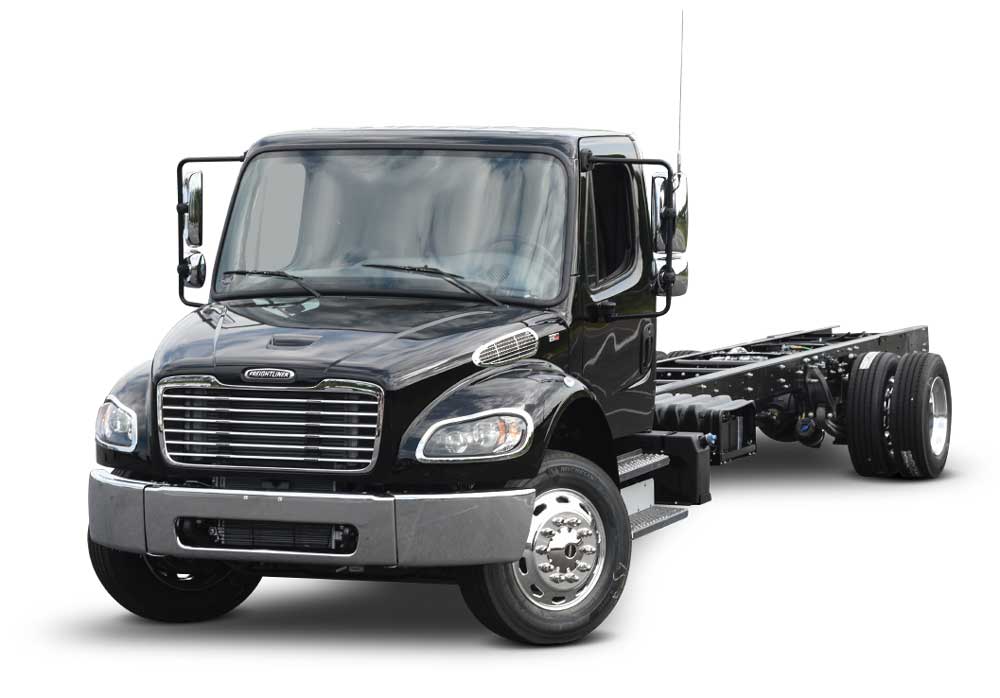
Our take
If we’re being honest, the main reason some of us love diesels can be traced back to childhood, gawking at hulking 18-wheelers at rest areas and truck stops, wondering what it must be like to drive one. If you never had your chance, the Freightliner S2RV chassis serves two purposes: It’s a strong foundation for a home on wheels, and it’s about as close to a commercial truck as you’re going to get, without actually driving one. We love climbing into the cab, turning the key and experiencing the visceral sensation of that diesel coming to life under the sloping hood. Commercial roots mean this chassis is designed for the long haul.
What we’d like to see
More power. The 6.7-liter HO Cummins available in Ram HD trucks makes more power and torque than the top offering in the S2RV. Offering a 400-hp with 1,000 lb-ft of torque would have a nice ring to it.
GM/Chevrolet
Engine: 6.0-liter Vortec V-8, 341 hp/373 lb-ft
Transmission: Six-speed automatic
Drive system: Rear wheel drive
Suspension front/rear: Independent/leaf spring
Brakes: 4-wheel disc with ABS
Wheelbase(s): 159″, 177″
Fuel capacity: 33 gal
GVWR: 14,200 lbs
GCWR: 20,000 lbs
Tow Rating: Based on finished vehicle
Warranty: 3 years/36,000 miles
Our take
Built by Navistar for GM and branded as a Chevrolet product, the Express 4500 cutaway chassis packs GM’s smooth, strong-running 6.0-liter V-8 engine and available options like OnStar 4G LTE with built-in hot spot and available Chevrolet MyLink with Navigation. A recent test of a motorhome on this chassis revealed some fitment issues that we felt could be improved upon. If you’re a Chevy fan, this is your likely choice, but keep an open mind and drive the Ford E-Series as well.
What we’d like to see
Better build quality. Some of the tech from their other lines migrating into the motorhome chassis.
Mercedes-Benz (Sprinter)
Engine: 3.0-liter V-6 turbodiesel, 188 hp/ 325 lb-ft
Transmission: Five-speed automatic
Drive system: Rear wheel drive (cutaway chassis); Rear wheel drive/four wheel drive (van)
Suspension front/rear: Independent, strut/beam axle with leaf springs
Brakes: 4-wheel disc brakes with ABS
Wheelbase(s): 144″, 170″
Fuel capacity: 26.4 gal (cutaway chassis) 24.5 gal (van)
GVWR: Max 11,030 lbs (cutaway chassis) 9,330 lbs (van)
GCWR: Max 15,250 lbs (cutaway chassis) 13,550 lbs (van)
Tow Rating: 7,500 lbs (cutaway chassis) 5,000 lbs (van)
Warranty: 3 years/36,000 miles
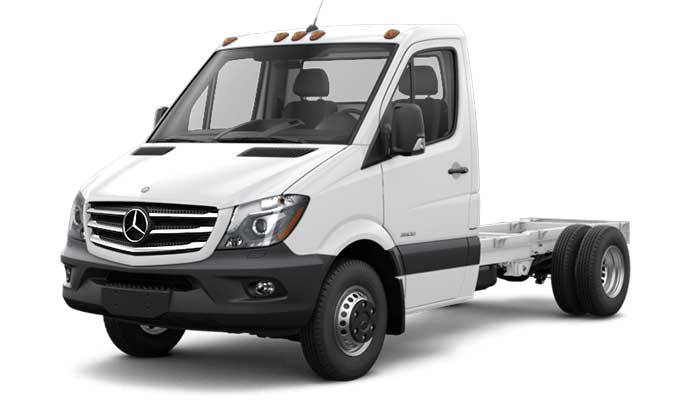
Our take
It’s got the cache of the three-pointed star, which many manufacturers and consumers alike tend to covet — and it is the only product of its type to be offered with 4WD. But from this author’s experiences, this chassis could use some improvement. The diesel engine options offer adequate power, but the steering feels numb on center, the brakes are a bit spongy and, depending on the unit and how it was loaded, the handling doesn’t inspire confidence. Not everyone on staff feels the same way, which underscores the fact that chassis dynamics can be subjective. For years, the Sprinter had a firm grip on the Class B chassis crown, but now that the Ford Transit is here, we’d recommend you try both and decide what works best for you.
What we’d like to see
A better Sprinter. The American-built 2019 model is on its way (at press time), with an available gasoline engine, two diesel engine choices, a seven-speed automatic transmission and a revised interior with a new infotainment system. Time (and testing) will tell how well Mercedes is responding to the competition.
RAM ProMaster
Engine: 3.6-liter V-6, 280 hp/260 lb-ft
Transmission: Six-speed automatic
Drive system: Front wheel drive
Suspension front/rear: Independent, strut/beam axle leaf springs
Brakes: 4-wheel disc brakes with ABS
Wheelbases: 136″, 159″ (cutaway chassis); 118″, 136″, 159″ (van)
Fuel capacity: 24 gal
GVWR: Max 9,350 lbs (van and cutaway chassis)
GCWR: 11,500 lbs (gas)/ N/A (diesel)
Max towing: 5,100 lbs
Warranty: 3 years/36,000 miles
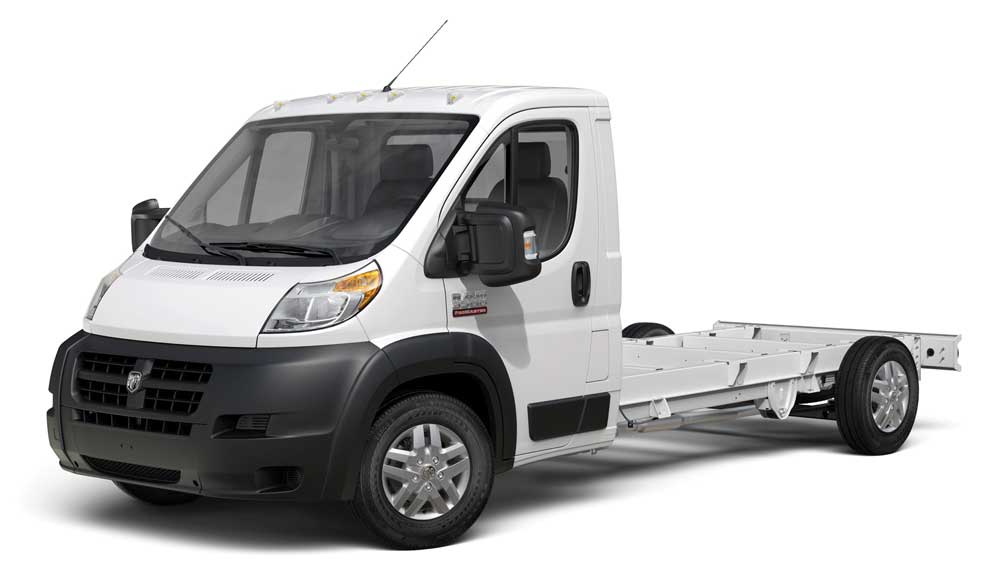
Our take
There’s no gentle way to say this … in my opinion the RAM ProMaster is the ugly duckling of the van chassis ranks, but what it lacks in good looks it could well make up for in practicality for the right buyer. First and foremost, the ProMaster is the only van chassis in its class with front wheel drive, which could be beneficial to four-season enthusiasts who may encounter icy/snowy roads. Torque steer — or the influence of engine torque on the steering wheel — can be an issue under hard throttle, but otherwise the chassis is well-sorted. In addition, Fiat Chrysler Automobiles (FCA) claims that having the drivetrain beneath the cab keeps the cargo load floor and step-in height very low. Available in 18 configurations, the 2019 ProMaster also offers several claimed best-in-class features, including the most available horsepower and the highest payload ratings.
What we’d like to see
We’re not the superficial type, but this baby could use a nose job. Just saying.
Spartan
Engine(s): Cummins X15 turbodiesel, 605 hp/ 1,950 lb-ft (K3 and K4 605 chassis); Cummins ISX12 turbodiesel, 500 hp/1,645 lb-ft (K3 500 chassis); Cummins L9 turbodiesel, 450 hp/ 1,250 lb-ft (K2 450 chassis); Cummins B6.7 turbodiesel, 360 hp/800 lb-ft (K1 360 chassis).
Transmission(s): Allison 4000MH six-speed (K3 and K4 605 chassis, K3 500 chassis); Allison 3000MH (K2 450 chassis, K1 360 chassis)
Drive system: Rear wheel drive
Suspension front/rear*: Independent front air suspension/non-torque reactive parallelogram air suspension and integrated passive steering tag axle (K3 and K4 605 chassis, K3 500 chassis, K2 450 tag axle chassis); Independent front air suspension/non-torque reactive parallelogram air suspension (K2 450 chassis); Hendrickson independent front suspension/Hendrickson HTB210 parallelogram (K1 360 chassis)
Brakes: Air disc with ABS, all axles (K3 and K4 605 chassis, K3 500 chassis); air disc front, air drum drive and tag axles with ABS (K2 450 tag axle chassis), front/rear air disc with ABS (K2 450 chassis); air disc front/air drum rear with ABS (K1 360 chassis)
Wheelbases*: 316″ (K3 and K4 605 chassis); 270″/318″ (K3 500 chassis); 276″/312″ (K2 450 tag axle chassis) 261″ (K2 450 chassis); 236″ (K1 360 chassis)
Fuel capacity: 200 gal (K4 605 chassis); 150 gal-200 gal (K3 605 chassis); 150 gal (K3 500 chassis) 100 gal-150 gal (K2 450 chassis); 100 gal (K1 360 chassis)
GVWR: 32,000-54,000 lbs
GCWR: 42,000-74,000 lbs
Tow rating: 10,000-20,000 lbs
Warranty: 3 years/50,000 miles
*Specifications may vary depending on coach manufacturer
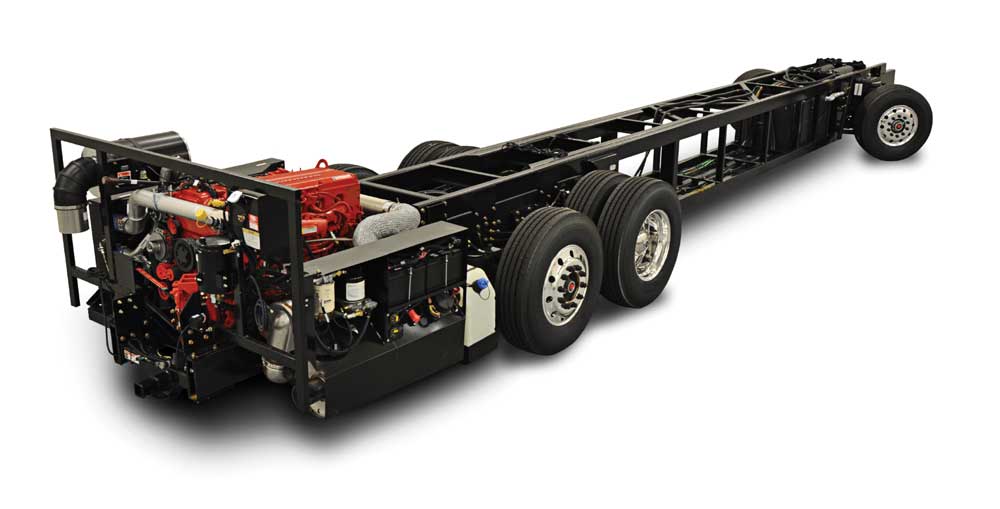
Our take
With a manufacturing portfolio that includes a wide range of emergency response, defense, fleet and specialty chassis manufacturing, Spartan Chassis’ reputation is pretty much beyond reproach. Spartan offers a variety of chassis to the RV industry as well, catering to some high-end manufacturers like Foretravel, Entegra, Newmar, Tiffin and others. In all, Spartan offers six chassis for RV manufacturers, ranging from the K1 360 with a single rear axle to the K4 605 with a Passive Steer Tag Axle. Spartan chassis provide confident handling, a velvety ride and powerful brakes. Suffice it to say, we don’t have room to list the features and benefits of every chassis in Spartan’s line, but the company website offers detailed information on each of its chassis and which manufacturers use them as the basis for their products.
What we’d like to see
With impressive build quality, a great ride and an array of smart features, we honestly can’t think of anything.

